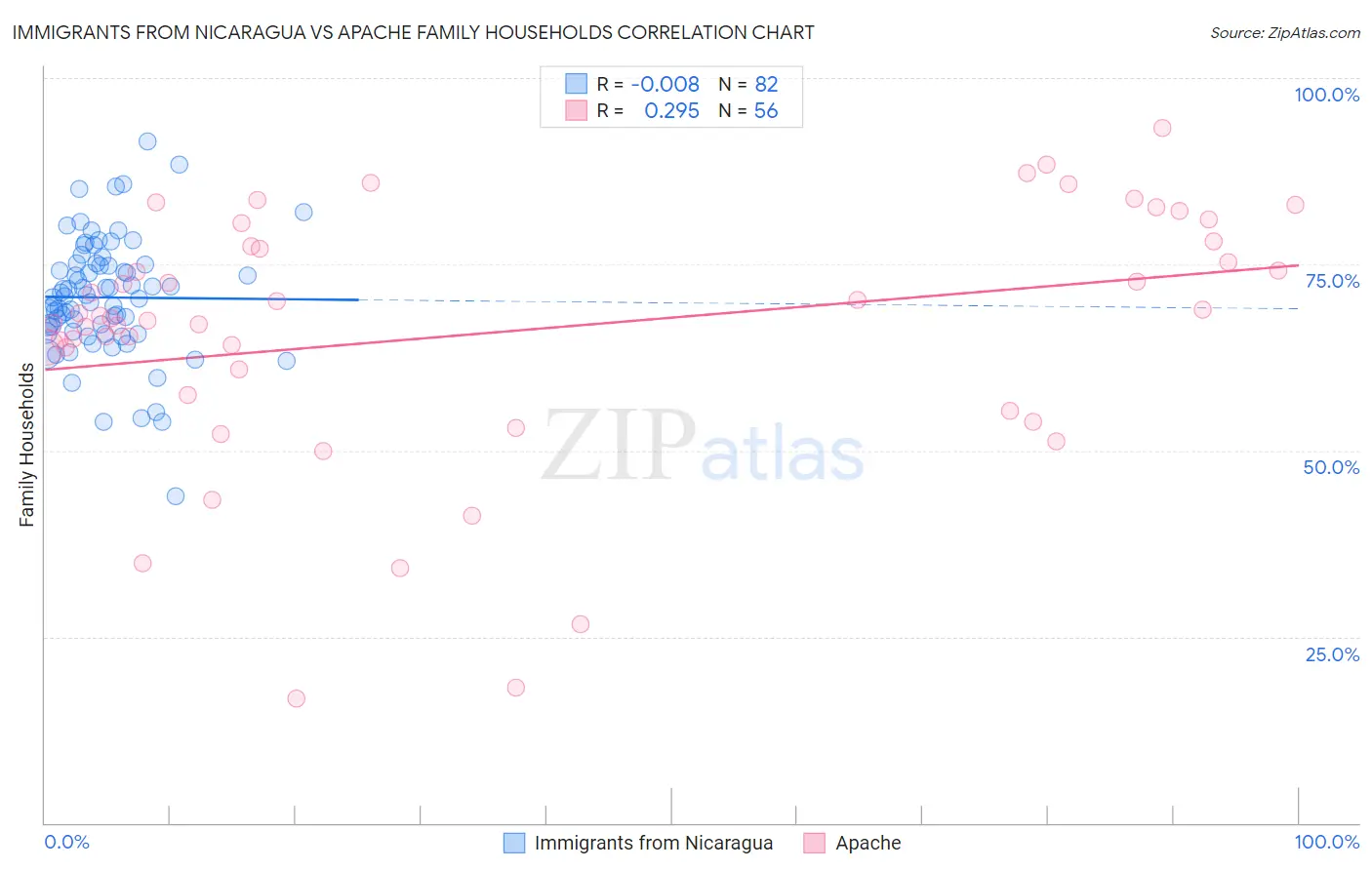Immigrants from Nicaragua vs Apache Family Households
COMPARE
Immigrants from Nicaragua
Apache
Family Households
Family Households Comparison
Immigrants from Nicaragua
Apache
67.5%
FAMILY HOUSEHOLDS
100.0/ 100
METRIC RATING
25th/ 347
METRIC RANK
66.5%
FAMILY HOUSEHOLDS
100.0/ 100
METRIC RATING
43rd/ 347
METRIC RANK
Immigrants from Nicaragua vs Apache Family Households Correlation Chart
The statistical analysis conducted on geographies consisting of 236,325,985 people shows no correlation between the proportion of Immigrants from Nicaragua and percentage of family households in the United States with a correlation coefficient (R) of -0.008 and weighted average of 67.5%. Similarly, the statistical analysis conducted on geographies consisting of 231,040,944 people shows a weak positive correlation between the proportion of Apache and percentage of family households in the United States with a correlation coefficient (R) of 0.295 and weighted average of 66.5%, a difference of 1.4%.

Family Households Correlation Summary
| Measurement | Immigrants from Nicaragua | Apache |
| Minimum | 43.9% | 16.7% |
| Maximum | 91.5% | 93.2% |
| Range | 47.5% | 76.6% |
| Mean | 70.5% | 66.0% |
| Median | 70.7% | 67.9% |
| Interquartile 25% (IQ1) | 66.0% | 59.1% |
| Interquartile 75% (IQ3) | 75.0% | 77.7% |
| Interquartile Range (IQR) | 9.0% | 18.6% |
| Standard Deviation (Sample) | 8.0% | 17.1% |
| Standard Deviation (Population) | 7.9% | 16.9% |
Demographics Similar to Immigrants from Nicaragua and Apache by Family Households
In terms of family households, the demographic groups most similar to Immigrants from Nicaragua are Immigrants from India (67.4%, a difference of 0.010%), Immigrants from South Eastern Asia (67.5%, a difference of 0.020%), Hispanic or Latino (67.4%, a difference of 0.050%), Hawaiian (67.4%, a difference of 0.070%), and Nicaraguan (67.4%, a difference of 0.14%). Similarly, the demographic groups most similar to Apache are Menominee (66.5%, a difference of 0.010%), Asian (66.5%, a difference of 0.050%), Immigrants from Bolivia (66.6%, a difference of 0.070%), Guamanian/Chamorro (66.6%, a difference of 0.10%), and Immigrants from El Salvador (67.0%, a difference of 0.68%).
| Demographics | Rating | Rank | Family Households |
| Immigrants | South Eastern Asia | 100.0 /100 | #24 | Exceptional 67.5% |
| Immigrants | Nicaragua | 100.0 /100 | #25 | Exceptional 67.5% |
| Immigrants | India | 100.0 /100 | #26 | Exceptional 67.4% |
| Hispanics or Latinos | 100.0 /100 | #27 | Exceptional 67.4% |
| Hawaiians | 100.0 /100 | #28 | Exceptional 67.4% |
| Nicaraguans | 100.0 /100 | #29 | Exceptional 67.4% |
| Immigrants | Peru | 100.0 /100 | #30 | Exceptional 67.2% |
| Immigrants | Latin America | 100.0 /100 | #31 | Exceptional 67.2% |
| Nepalese | 100.0 /100 | #32 | Exceptional 67.2% |
| Salvadorans | 100.0 /100 | #33 | Exceptional 67.2% |
| Thais | 100.0 /100 | #34 | Exceptional 67.2% |
| Tohono O'odham | 100.0 /100 | #35 | Exceptional 67.1% |
| Peruvians | 100.0 /100 | #36 | Exceptional 67.1% |
| Tsimshian | 100.0 /100 | #37 | Exceptional 67.1% |
| Mexican American Indians | 100.0 /100 | #38 | Exceptional 67.0% |
| Immigrants | El Salvador | 100.0 /100 | #39 | Exceptional 67.0% |
| Guamanians/Chamorros | 100.0 /100 | #40 | Exceptional 66.6% |
| Immigrants | Bolivia | 100.0 /100 | #41 | Exceptional 66.6% |
| Menominee | 100.0 /100 | #42 | Exceptional 66.5% |
| Apache | 100.0 /100 | #43 | Exceptional 66.5% |
| Asians | 100.0 /100 | #44 | Exceptional 66.5% |